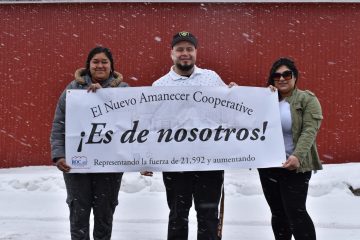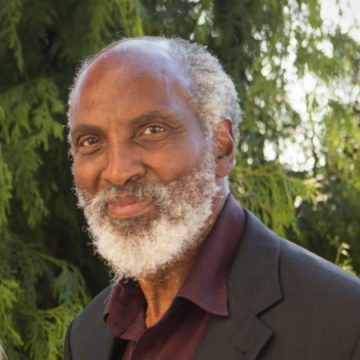Bush Learning
Building a stellar staff
DATE
February 17, 2018
Recruiting and Selection with an Equity Lens
Contributor: Stephanie Andrews
Since 2013, the Bush Foundation has been working to create a more equitable and inclusive culture internally so that we can be more effective externally. In another paper, Building an Inclusive Culture, we’ve shared the Foundation’s experience and lessons from the first five years of focused equity work. This current piece focuses on a single piece of that equity work — sharing the strategy and tactics we use related to recruitment, selection and hiring. Many of these strategies are common practice with other organizations who share the goal of diversifying their workforces. We’ve learned from (and borrowed) many ideas from our colleagues in this field and others. We share these ideas in the hopes that readers might learn from, borrow and add to them as well.
We start with the belief that we’re more effective when our staff reflects a wide range of perspectives and life experiences. The field of philanthropy has a particular obligation to incorporate many perspectives in order to serve communities well. Institutionalized racism, implicit bias and homogeneous networks get in the way of building the strongest possible team, and we use a variety of strategies in our recruitment and hiring processes to address these issues. Our attorneys are important partners in these efforts, and we stay closely in touch with them to understand the legal boundaries of what we can and can’t do.
Our goal is to widen applicant pools so that we have candidate slates that are diverse, both racially and otherwise. We take a broad view of diversity, looking for candidates from historically marginalized backgrounds and candidates that bring other types of unique perspectives to our work. Achieving diverse candidate pools often means looking beyond philanthropy for our next colleague so that we may draw from a talent pool more diverse than offered by this still largely homogeneous and white-dominated sector.
We get to practice these processes because we recruit and hire a lot. Our talent strategy encourages career mobility because we hire really talented people and our organization is small with sometimes limited prospects for upward movement. (Read Internal Talent Strategy for External Impact for more information on this.) In each of the last five years, we’ve filled at least 6 positions, with a turnover rate between 10 and 18 percent. The applicant pools for our jobs are usually large — rarely fewer than 50 and sometimes as high as 180. Last year (2018), over 700 people applied for jobs at the Bush Foundation.
Based on our experience, here are some tactics that can help bring an equity lens to the hiring process.
Defining the role and widening the applicant pool
- Focus on the gaps. Ask hiring managers to consider the perspectives and experiences that would add value to their team, in addition to the other skills that they need to find in an individual. This view sends us into the recruiting process looking at how we can add balance, perspective, life experience and diversity to our talented candidate pool and keeps us focused on where we might find prospective and diverse candidates
- Be specific about the skills that you want in job postings and job descriptions. Avoid using inflexible credentials and minimum qualifications — like educational degrees or certifications — as blunt stand-ins for more specific skills. We’ve eliminated credential ‘proxies’ that often don’t provide value in and of themselves but are assumed to reflect a work ethic or set of skills. If you want someone with good writing skills and the proven ability to meet deadlines, say that. You’ll be clearer on what you’re trying to find and the pool of applicants will be wider.
- Be wary about asking for experience in philanthropy. In a sector where people of color are already underrepresented, requiring that people come in with this experience only perpetuates the lack of diversity. If you’re looking for experience that will make someone suitable to do grantmaking work, you can ask for experience reviewing proposals and making recommendations, whether or not grant-related, opening up your applicant pool to people with relevant experience in the private and public sectors.
- Deep interest in building intercultural competence needs to be both a job responsibility and a minimum qualification. Sometimes we hire people who have a lot of formal experience in diversity, equity and inclusion work and sometimes we hire people with more interest than experience. Either way, signaling commitment to DEI work gives applicants a glimpse into the culture, goals and expectations of their potential employer.
Sourcing candidates
Long-term strategies:
- Your equity brand matters. Top candidates always have options. Your organization’s “equity cred” will be a key factor in whether you’ll be able to have applicant pools that are deep and diverse.
- Build relationships ahead of vacancies so you’re ready. Reach out to affinity groups, and community organizations so that you have fertile ground and ‘warm’ contacts when you have a job to fill — people who know you and your organization and trust that the people they’ve mentored and nurtured will be in good hands if they go to work with you.
In the moment:
- Make it easy for people to figure out what the job — and the organization — is all about. This seems obvious, but jobs in philanthropy are often seen as appealing AND a bit mysterious. Seek to demystify.We do webinars for every job, a couple days after the posting has gone public. The hiring manager talks about the work, the team, who might flourish in the role — and importantly, who the job isn’t for — as in “…if you are someone who relishes a predictable day where you rock your to-do list with no interruptions, this job is not for you!”Applicants can participate anonymously and can submit questions that we answer for everyone to hear. We tell them what we’ll pay. We include photos of our staff to show that we are a diverse lot. Applicants tell us that these webinars help them feel less nervous when they come to interview — already feeling as if we are familiar to them — and made them more (or less) interested in the job. Either way, it’s a win for us and them.
- Go beyond the usual job boards. Are there organizations whose people and work you consistently admire? If so, give a second look to people who worked there. You have some data to suggest that their talent lens is aligned with yours. Ask your staff to help identify top notch potential colleagues. Some organizations provide incentives and recognition when staff share postings or identify good leads.
Narrowing the field
- Be a talent scout. Jobs in philanthropy tend to be competitive with large applicant pools. You’ve got a huge pile of files in front of you and human brains want to apply rules to make sense of it all. Guard against the natural tendency to select only people who are like you by including more eyes in the application review stage. We have at least three people — the hiring manager and two Talent staff — review every application and any candidate who sparks the interest of at least one reviewer gets discussed in more depth. We review the applicants against the minimum qualifications we’ve announced in the job posting and are vigilant about not making decisions on criteria other than what we’ve intended.
- Know your pool. The Talent staff keep an eye on diversity, defined broadly, as we narrow the field. As we start to say ‘yes’ and ‘no’ to candidates, we keep an eye on whether the pool has sufficient geographic, racial, cultural, gender and sector diversity to promote opportunity for us to hire top candidates that address perspective gaps identified up front as particularly valuable to the team and the Foundation. If we don’t see enough, we go back to look at candidates who have shared these aspects of their identity to make sure that they aren’t being screened out. When in doubt, we add another interview slot or two, knowing that unintentional, but implicit bias may have excluded people with experience that’s further afield.
Interviewing
- Use structured questions. Research shows that unstructured interviews increase the chance that interviewers rely on their own stereotypes to guide their impressions. Decide on questions that will help you test whether candidates have demonstrated the skills you’re looking for and use them with each interview. Compare candidates question by question to avoid having overall impressions hold sway. Include a variety of ways for the applicants to show their stuff — written, verbal, pre-prepared exercises, real life scenarios and role play. Make sure that such screening methods are validly tied to the job’s requirements and don’t disparately impact and screen out groups of candidates.
- Choose neutral topics for small talk. Interviewers need to be careful about small talk that draws on shared connections, experiences or identities. It may feel comfortable for you, but also is likely to give candidates who are more familiar with you, your organization or the sector a leg up on others.
- Default to in-person or face to face interviews. Phone interviews are efficient and effective at screening candidates out but we don’t use them anymore because they can exacerbate power dynamics and leave candidates feeling unsatisfied that they’ve had a good shot at making their case. I know that it’s too easy for me to develop easier rapport over the phone with people who I have a lot in common with and too difficult for people who are less comfortable with English, or less familiar with traditional interview processes, to feel as if they presented their best self.
- Be a good host. Find out ahead of time, in a confidential manner, if applicants need accommodations on time, place or physical set-up of the interview place. You might do this by including information in job postings or in prep calls about interview logistics. When the applicant arrives, help make them comfortable. Smile a lot. Remind interviewers that their role is to help this person show off their best selves, not to trip them up. We provide a ton of detail on what’s going to happen in each interview and we stick to what we say we’re going to do.
- Include as many perspectives as you can in the interviews. We invite staff from across the Foundation to participate, making sure the interview panels reflect the racial and cultural diversity of our staff and a variety of roles. Candidates meet with people who would be their peers and with members of the team they would join. We do references earlier than most employers and use a pre-hire consultant to interview finalists for all jobs so that we can keep adding new perspectives as we narrow our choices. Our decisions are better for the many views we include.
Room to improve
Our process is time intensive for both applicants and us and we wonder if using technology like video interviewing could minimize applicant travel and prep time while still meeting our relational goals. We are looking at how we might legally and respectfully collect more demographic information on the front end so that we can minimize the guessing that we resort to as we try to understand the applicant pool. We have recently completed a survey of people who have applied for positions and we’ll be looking carefully at their responses and adjusting our process based on the results.
We have the most room to grow in developing productive and closer relationships with affinity groups and other community organizations. Our work on equity has provided diverse talent pools without too much of this, but that still leaves out people who don’t know about the Foundation or our work.
We’re also eager to see the executive search field become more racially diverse itself and more adept at developing racially diverse candidate pools. We will continue to be a demanding client on retained searches and are developing an inventory of search partners who are interested in working with us and willing to discuss the steps they take to ensure an inclusive process and a diverse pool.
Continue reading
-

Story
CoNorth helps residents take ownership
A model of cooperative ownership for manufactured home communities is expanding what affordable housing can look like
-

News
Power of Bridging event
Mark your calendars for a special community event with john a. powell! Thanks to our friends at MPR News, we'll be hosting john at the Fitzgerald Theater on December 2 and hope you can join us!
-

News
Celebrating the 2025 Bush Prize honorees
Learn more about the 2025 Bush Prize honorees who are helping to make our region better for everyone!